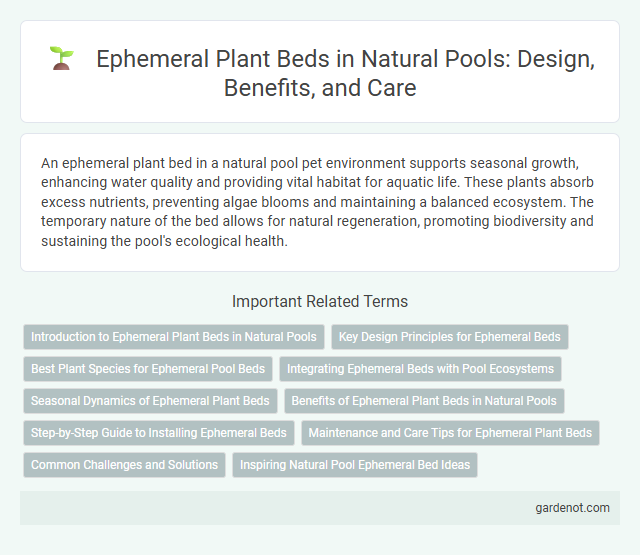An ephemeral plant bed in a natural pool pet environment supports seasonal growth, enhancing water quality and providing vital habitat for aquatic life. These plants absorb excess nutrients, preventing algae blooms and maintaining a balanced ecosystem. The temporary nature of the bed allows for natural regeneration, promoting biodiversity and sustaining the pool's ecological health.
Introduction to Ephemeral Plant Beds in Natural Pools
Ephemeral plant beds in natural pools serve as temporary habitats that support early successional plant species thriving in fluctuating water levels. These beds enhance biodiversity by providing essential breeding grounds for amphibians and shelter for aquatic insects during seasonal drying phases. Integrating ephemeral plant beds into natural pool design promotes ecological balance by mimicking natural wetland cycles and improving water quality through nutrient uptake.
Key Design Principles for Ephemeral Beds
Key design principles for ephemeral plant beds in natural pools emphasize using native plant species adapted to seasonal water fluctuations, ensuring root systems stabilize soil while tolerating periodic drying. The bed layout should promote efficient water drainage and aeration to prevent stagnation and support diverse microhabitats. Integrating biofiltration zones and layering plants by height enhances nutrient uptake and supports overall pool ecosystem health.
Best Plant Species for Ephemeral Pool Beds
Ideal plant species for ephemeral pool beds include amphibious varieties like Marsilea mutica, Eleocharis acicularis, and Sagittaria latifolia, which thrive in fluctuating water levels. These plants support biodiversity by providing habitat and nourishment for aquatic invertebrates during wet phases and survive dry periods through resilient root systems. Selecting native species adapted to local hydrology enhances the ecological balance and promotes water quality in natural pool ecosystems.
Integrating Ephemeral Beds with Pool Ecosystems
Integrating ephemeral plant beds within natural pool ecosystems enhances water purification by supporting seasonal nutrient cycling and providing habitats for beneficial microorganisms. These transient beds improve biodiversity, fostering a balanced aquatic environment that reduces algae growth naturally. Designing ephemeral plant zones with native species ensures adaptability to fluctuating water levels, optimizing ecological function and aesthetic appeal.
Seasonal Dynamics of Ephemeral Plant Beds
Ephemeral plant beds in natural pools exhibit distinct seasonal dynamics, thriving during wet periods and entering dormancy as water levels recede. These beds support biodiversity by providing temporary habitats for specialized flora and fauna adapted to fluctuating moisture conditions. Seasonal changes influence nutrient cycling and sediment stabilization, contributing to the overall ecological balance of the natural pool ecosystem.
Benefits of Ephemeral Plant Beds in Natural Pools
Ephemeral plant beds in natural pools enhance water quality by naturally filtering pollutants and providing habitat for beneficial microorganisms. These beds support biodiversity and stabilize pool ecosystems by offering seasonal habitats for native aquatic plants and animals. The dynamic growth cycles of ephemeral plants help reduce algae growth and improve overall pool aesthetics through natural, sustainable means.
Step-by-Step Guide to Installing Ephemeral Beds
Creating an ephemeral plant bed in a natural pool involves excavating a shallow area, typically 15-30 cm deep, to ensure periodic drying that supports temporary aquatic plants. Layering nutrient-rich soil topped with sand provides ideal conditions for seed germination and root stability while preventing soil erosion. Carefully selecting native ephemeral species and planting them at appropriate intervals enhances biodiversity and maintains water clarity by filtering sediments naturally.
Maintenance and Care Tips for Ephemeral Plant Beds
Ephemeral plant beds in natural pools require regular monitoring to ensure optimal growth and ecosystem balance. Remove dead or decaying plant material promptly to prevent nutrient buildup and maintain water clarity. Periodic trimming and controlled water flow adjustments support healthy plant regeneration and reduce algae proliferation.
Common Challenges and Solutions
Ephemeral plant beds in natural pools often face challenges such as fluctuating water levels, nutrient imbalances, and seasonal plant dieback. Managing water depths to maintain consistent moisture and implementing nutrient filtration techniques can promote healthy plant growth. Selecting native, resilient species adapted to temporary wet conditions enhances long-term sustainability and reduces maintenance needs.
Inspiring Natural Pool Ephemeral Bed Ideas
Ephemeral plant beds in natural pools create dynamic, seasonal displays by incorporating native wildflowers, grasses, and aquatic plants that thrive in fluctuating water levels. Designing these beds with diverse species such as irises, pickerelweed, and cattails enhances biodiversity while promoting natural water filtration and habitat for local wildlife. Strategic placement near shallow zones maximizes sunlight exposure and ensures optimal growth, making ephemeral beds a vital element for sustainable, inspiring natural pool landscapes.
Ephemeral plant bed Infographic

 gardenot.com
gardenot.com